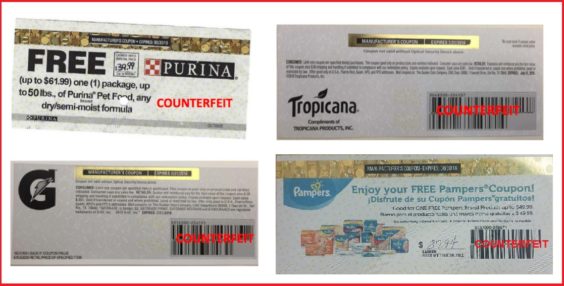
Just a few months ago, manufacturers began imprinting many of their high-value and free-item coupons with a brand-new gold hologram, which was developed by the coupon industry to help combat counterfeiters.
And a few months later, confirmed counterfeit coupons bearing gold holograms are out there – and they’re being sold online, and redeemed in stores, at an increasing rate.
If the new hologram was meant to be an industry stamp of approval, aimed at confirming the legitimacy of coupons that include the feature, it appears that’s not quite the case anymore. Coupon counterfeiters have managed to beat back this latest effort to thwart them, in record time.
In secret Facebook groups, and elsewhere online, several sellers are offering “unicorns” – which is lingo for counterfeit high-value coupons. In one group, the organizer is advertising the availability of “manufacturer coupons with gold CIC foil holograms.” Whether that’s meant to assure buyers of the coupons’ validity – or it’s a winking reference to the coupons being high-quality, difficult-to-detect fakes – is unclear. But each coupon features a gold-hologrammed strip across the top, surrounding the expiration date, which appears to the casual observer to be the real thing.
But the coupons are anything but real. The first sign of this new breed of counterfeit coupons cropped up more than a month ago. And their existence was officially acknowledged this week, when several fraudulent coupons featuring gold holograms showed up on the Coupon Information Corporation’s list of known counterfeits.
“The member companies are aware that the gold hologram has been compromised,” a representative from one of the affected companies told Coupons in the News. “And they’re not happy about it.”
The gold hologram replaced an earlier, silver version of the hologram that was introduced several years ago. Each of the holograms features three-dimensional images on a special foil strip, that’s imprinted on coupons to signify to consumers and cashiers that the offers are the real deal.
“A hologram is instantly recognizable. All a cashier has to do is just take a look at it,” CIC Executive Director Bud Miller said at the time the silver hologram was introduced. “They will be able to verify that there is a CIC hologram on the coupon as quickly as their eye can see it.”
But some of the more sophisticated counterfeiters soon learned that the best way to make their fake coupons look real, was to fake the hologram. In one of the most notorious examples of how the silver hologram had been compromised, three Phoenix women convicted of selling high-quality counterfeits made a brazen offer to customers – for an extra $3, they’d slap a silver holographic sticker on any coupon that was purchased, to make it look more “real”.
So the CIC came out with a new, replacement hologram this year – and made it gold. The new version, which contains additional features and was considered much more difficult to counterfeit, was officially unveiled earlier this year.
“Anything you can do to make it more difficult for the counterfeiters to succeed is a benefit,” Miller said upon the gold hologram’s launch.
Just not as difficult as he might have liked. “It took several years for the prior hologram to be counterfeited,” Miller told Coupons in the News this week. “We are disappointed that the criminal element was able to switch foil tints so quickly.”
“The counterfeiters have just stepped up their game and are making even better-looking counterfeits,” Jill Cataldo told Coupons in the News. Cataldo, a nationally-syndicated coupon columnist and blogger, wrote about the gold holograms and displayed images of several fake hologrammed coupons on her website last week. “Over the past month, some of my readers have been spotting numerous gold-hologram free-product coupons for sale in Facebook groups and asking me about them,” she said. “There seems to be a belief out there that if a coupon has the gold hologram on it, it’s 100% genuine and fine to use. Nothing could be further from the truth.”
“The appearance of a hologram on a coupon is no guarantee that it is legitimate,” Miller acknowledged. “It is an unfortunate fact that, with enough effort, anything can be counterfeited.”
So doesn’t the fact that some coupon holograms have been counterfeited, now make every coupon hologram suspect?
Miller said an expert eye can tell the difference. “The current counterfeits we have observed are easily distinguishable from the real gold holograms,” he said.
That may help coupon issuers identify the fakes, once they make their way through the system. But it’s not much help to consumers or cashiers on the front lines, who now have reason to question any coupon with a hologram – if they pay attention to the hologram at all.
Even more worrisome, some of the current crop of fraudulent coupons appear to be printed on special paper stock, of the type that’s used to produce actual coupons. The paper includes various anti-counterfeiting features, such as special watermarks that appear when a coupon is photocopied – and a gold hologram across the top.
And if fraudulent coupons are being printed on genuine secure paper, featuring genuine holograms, the industry may have a different, bigger problem on its hands.
A company called Crown Roll Leaf produces the gold holograms, and makes them available only to authorized printers approved by the CIC. One such printer is Micro Format, Inc., which imprints the holograms on secure paper, then makes that paper available to authorized coupon issuers.
And Micro Format insists it has procedures in place to ensure it does not sell its special paper to any would-be counterfeiters. “We vet every customer who purchases our product,” Aaron Singer, Micro Format’s Document Security Specialist, told Coupons in the News. “It is not available to the general public.”
The CIC is currently investigating whether there’s a security breach somewhere along the line that’s allowing hologram paper to get into the wrong hands, or whether the counterfeiters have gotten so good, that their handiwork is virtually indistinguishable from the real thing.
The whole situation has proven especially frustrating to many CIC members, who had hoped the gold hologram would be more effective in protecting them against counterfeiters – at least for a while longer. The next steps at this point, are still unclear. “We haven’t made a decision on what to do, or whether to give it up,” said a representative of one company whose coupons have been counterfeited.
Whether the industry ends up developing yet another hologram, or some other method of thwarting counterfeiters, the best way to combat the suppliers is, ultimately, to dry up demand. “Consumers can easily protect themselves from counterfeit coupons by only using coupons they have obtained directly from the manufacturer or their authorized representatives,” Miller said. High-value and free-item coupons are typically sent directly to individual consumers from companies, and not in large batches. So anyone who has large batches of coupons to sell, is suspect. “Brands aren’t providing these Facebook groups with coupons to sell,” Cataldo said.
Only when people stop buying, will coupon counterfeiters go out of business – whether their coupons feature holograms or not.
















I have never seen a coupon with a hologram.
Eventually companies are just going to stop printing and giving out coupons. It has gotten to the point of being ridiculous now. How do you know what is legit and what is counterfeit now. This is why when using coupons cashiers make it seem like you are some criminal. Will eventually stop using coupons, tired of being profiled as a criminal when I’m just trying to use a 10 cents off coupon.
Wow, what is the point of these new gold holograms!? Seems like a colossal waste of time and money! And even the most seasoned cashier couldn’t possibly differentiate a real one from a fake one. Sounds like a classic case of “the blind leading the blind”!